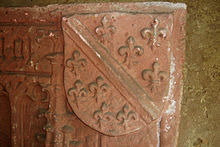Lords of Ehrenberg (Lower Moselle)

The imperial ministerial lords of Ehrenberg (also Eremberch, Eerenberg) of the Lower Moselle are certified as noblemen , knights and lords of the Ehrenburg between 1189 and 1398 .
history
The Lords of Ehrenberg named themselves after the castle, which they probably built at the beginning of the 12th century - originally as a square residential tower - in a side valley of the Lower Moselle . 1161 this castle is in a settlement document Emperor Frederick I of Archbishop Hillin of Trier and Count Palatine Konrad von Staufen with castrum eremberch referred. A photo from the 1950s shows in front left, in front of the two towers, the remains of the upper castle wall, which was built in several phases of expansion in the 12th and 13th centuries. Century was expanded to a "permanent house". The double keep is said to have been built between 1325 and 1350. The upper castle and keep stand at the highest point of a mountain spur protruding into the Ehrbach valley.
In 1189 Friedrich von Ehrenberg and his son appear as witnesses for Konrad von Staufen in a Cologne document. Lendings with bailiffs and possessions u. a. of the Cologne church and the Siegburg abbey in the Middle Rhine-Untermosel region of the 12th century, and their notarized proximity to the Rhineland Count Palatine already at this time, suggest that the family came from the northern Rhineland. Four Ehrenbergers alone are in the 13th and 13th 14th century canons of Cologne .
Their ancestral seat, the castle over the Eere , was the fortified administrative center of the imperial rule Ehrenberg with possessions on the front Hunsrück , the Middle Rhine and the Lower Moselle. This included the protection of a Moselle crossing between the Hunsrück and Eifel near Hatzenport . In addition to the income from offices, farms and villages in the region, the viticulture around Boppard , Brodenbach and Cochem will have secured them income.
Their ability to defend themselves is proven in 1314 by the promise made by two Ehrenberg brothers, Archbishop Balduin of Luxembourg , to serve him and his nephew King John of Bohemia with "12 heavy riders". It is also likely that she participated in the Italian procession of King Henry VII , Baldwin's brother, to Rome for the coronation of the emperor in the years 1310-1313. A Friedrich von Ehrenberg became marshal and standard-bearer of the Counts of Sponheim in 1368 .
Regarding regional politics, the gentlemen von Ehrenberg appear as bailiffs and Burgmanns in Boppard , Kastellaun and Simmern . They were also repeatedly opponents of the bishops of Trier - who, according to the conciliation document of Emperor Friedrich Barbarossa, had been lords of the Ehrenburg since 1161. Her Eltzer feud with Balduin and the long-term dispute with Werner von Falkenstein became known . Tradition describes the last Ehrenberger Friedrich VI. as an ardent rage at Koblenz, Böckelheim and other places of the Trier Archbishopric. 1398 mediate Count Palatine Ruprecht III. , the later German king, and Count Philipp I. von Nassau-Saarbrücken between both parties a settlement and reparation for victims and damages inflicted on each other by scorings Brand Doitslegen (document text for robbery, arson, manslaughter ).
coat of arms
The family coat of arms of the Ehrenbergers from the Lower Moselle shows a right-angled bar. Probably the oldest, still preserved colored representation shows the illustrated collection of the coats of arms of Trier castle men of Archbishop Baldwin, recorded around 1340. In the old French official language text of Baldwin, the tincture is denoted with H (err) de Ere (n) b (er) g. D'azur à la bande d'or (Herr von Erenberg. A golden sloping bar in blue). The seal of a Conrad v. E. von 1242 (LHA Ko Best 162 No. 42) shows, possibly to distinguish it from the coat of arms of the older, original family tribe, lily crosses as a symbol. Golden paw crosses or heraldic lilies later bear all the alliance coats of arms of the Ehrenbergers and their heirs.
There is no known evidence of a relationship with the Ehrenberg (noble family) of the same name from Heinsheim / Wimpfen am Neckar. A derivation of the name from the Middle High German êre for maple (tree) is cited on various occasions without further justification and is therefore difficult to understand.
Literature and Sources
without claim of completeness:
- Wilhelm Arnold Günther : Codex Diplomaticus Rheno-Mosellanus, documents of the XIVth century, Koblenz 1825, LHA Koblenz.
- Walter Möller: Family tables of West German noble families in the Middle Ages, NF page 110, Darmstadt 1951.
- Bernd Brinken: Konrad von Staufen's policy in the tradition of the Rhineland Palatinate, dissertation Bonn 1974.
- Johannes Mötsch : The Balduins. Structure, origin and content of the document collection of Archbishop Balduin von Trier, p. 145, Koblenz 1980, ISBN 3-922018-98-X , and with Jean-Claude Loutsch: The coat of arms of the Trierischen Burgmannen around 1340, p. 39 u. 140 ff., JbWdtLg 18 (1992), LHA Koblenz 1992.
- Elmar Rettinger: Historisches Ortlexikon Rheinland-Pfalz, Ehrenburg Burg (Gem. Brodenbach) , on the Internet at www.regionalgeschichte.net/.../EhrenburgHOL.pdf
- Ulrich Mehler: Little Castle Guide of the Ehrenburg , Ehrenburg 2008.
Individual evidence
- ^ Suzanne Beeh-Lustenberger, glass painting around 800-1900 in the Hess. Landesmuseum Darmstadt, there coat of arms of Elisabeth von Pyrmont and Ehrenberg, around 1480, p. 177, Frankfurt am Main 1967

